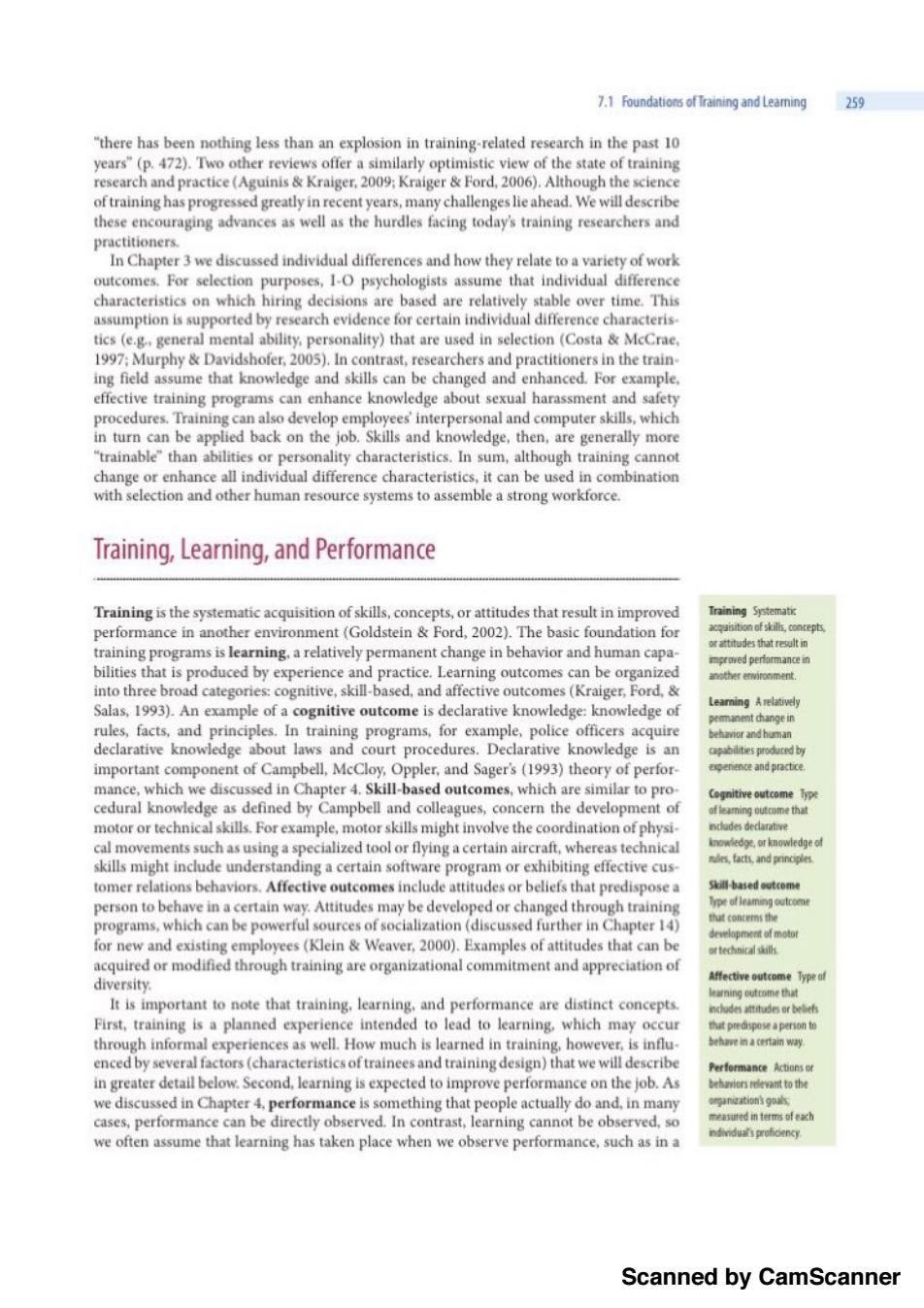正在加载图片...

7.1 Foundations of Training and Leaming 259 "there has been nothing less than an explosion in training-related research in the past 10 years"(p.472).Two other reviews offer a similarly optimistic view of the state of training research and practice (Aguinis Kraiger.2009:Kraiger Ford,2006).Although the science of training has progressed greatly in recent years,many challenges lie ahead.We will describe these encouraging advances as well as the hurdles facing today's training researchers and practitioners. In Chapter 3 we discussed individual differences and how they relate to a variety of work outcomes.For selection purposes,1-0 psychologists assume that individual difference characteristics on which hiring decisions are based are relatively stable over time.This assumption is supported by research evidence for certain individual difference characteris- tics (e.g,general mental ability.personality)that are used in selection(Costa McCrae. 1997:Murphy Davidshofer,2005).In contrast,researchers and practitioners in the train- ing field assume that knowledge and skills can be changed and enhanced.For example, effective training programs can enhance knowledge about sexual harassment and safety procedures.Training can also develop employees'interpersonal and computer skills,which in turn can be applied back on the job.Skills and knowledge,then,are generally more "trainable"than abilities or personality characteristics.In sum,although training cannot change or enhance all individual difference characteristics,it can be used in combination with selection and other human resource systems to assemble a strong workforce. Training,Learning,and Performance Training is the systematic acquisition of skills,concepts,or attitudes that result in improved Training Systemati performance in another environment(Goldstein Ford,2002).The basic foundation for acaisition of skills.conrepts rtttudes that resut in training programs is learning.a relatively permanent change in behavior and human capa- n字wtdp向mmance in bilities that is produced by experience and practice.Learning outcomes can be organized another eewiroement. into three broad categories:cognitive,skill-based,and affective outcomes(Kraiger,Ford, Learning Arelatively Salas,1993).An example of a cognitive outcome is declarative knowledge:knowledge of ea0t中angn rules,facts,and principles.In training programs,for example,police officers acquire behavior and human declarative knowledge about laws and court procedures.Declarative knowledge is an es prodared b可 important component of Campbell,McCloy,Oppler,and Sager's(1993)theory of perfor- agenence and practice mance,which we discussed in Chapter 4.Skill-based outcomes,which are similar to pro- Cognitive outcome Type cedural knowledge as defined by Campbell and colleagues,concern the development of motor or technical skills.For example,motor skills might involve the coordination of physi- cal movements such as using a specialized tool or flying a certain aircraft,whereas technical ledge.or knowtedgeof skills might include understanding a certain software program or exhibiting effective cus- sfarts and principles tomer relations behaviors.Affective outcomes include attitudes or beliefs that predispose a Skill-based outcome person to behave in a certain way.Attitudes may be developed or changed through training ype of leaming outcome programs,which can be powerful sources of socialization(discussed further in Chapter 14) that concerns the develnpment of motor for new and existing employees(Klein Weaver,2000).Examples of attitudes that can be technical sill acquired or modified through training are organizational commitment and appreciation of diversity. Affective outcome Type of learming outcome that It is important to note that training,learning.and performance are distinct concepts. ndudes attitudes or b时hh First,training is a planned experience intended to lead to learning.which may occur pedp0场aperson to through informal experiences as well.How much is learned in training,however,is influ- he销a6anwy enced by several factors(characteristics of trainees and training design)that we will describe Performance Actions or in greater detail below.Second,learning is expected to improve performance on the job.As behiorsevant to the we discussed in Chapter 4.performance is something that people actually do and,in many aon的gnk cases,performance can be directly observed.In contrast,learning cannot be observed,so ar树nt形时电h ndmidua自profidency we often assume that learning has taken place when we observe performance,such as in a Scanned by CamScannerScanned by CamScanner